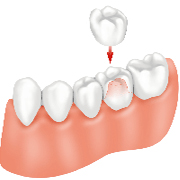
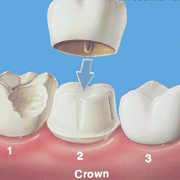



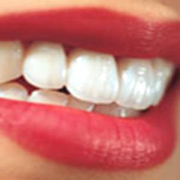
A dental crown or dental cap is a custom made restoration that covers a tooth with sustained significant loss of structure. They are analogical to being a thimble capped over your finger. Dental crowns are used to restore teeth to a certain shape and size. They provide strength and improves the appearance of the tooth.
There are three basic types of materials for dental crowns:
Porcelain fused to metal (PFM) dental crowns and all porcelain crowns are tooth colored crowns. PFM dental crowns offer the best combination of aesthetics and durability. PFM dental crowns are usually used to restore back teeth where the forces of chewing and grinding are strongest. All porcelain crowns are the most aesthetic and are used primarily used for front teeth where the need for strength is not as critical. Gold dental crowns are the most durable and offer the most precise fit. Gold dental crowns does not chip.
course of treatment described here is one of several options available at our dental clinic. Consult your dentist to find out what the best solution is for you, given your specific condition.
First evaluation and crowns tooth preparation
Both the preparation and placement of the temporary bridge as well as the bonding of the permanent bridge may cause some minor tenderness in the area. Some individuals may experience sensitivity in teeth. This sensitivity will disappear gradually over a few days to weeks.
Avoid chewing on or eating hard foods on the restorations for 24 hours from the time they were cemented
Dental crowns require the same regular and consistent home and professional dental care, as your natural teeth to prevent decay at the tooth-dental crown junction. To provide optimum longevity for your restorations, please follow the home care tips below:
Brush after eating and before bedtime around the crown with a soft toothbrush, especially where the crown meets the gum line. At the gum line harmful bacteria can be harbored to cause decay and gum disease.
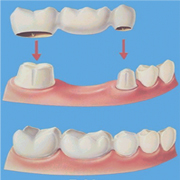
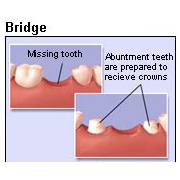



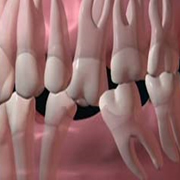
A dental bridge is one method to fill a gap created by a missing tooth (or teeth). Dental bridge or pontic is a custom-made false tooth or teeth, that is permanently placed between two healthy teeth, filling in the area left by a missing tooth or teeth. The bridge is held in place by crowns placed on the healthy teeth on each side of space to be filled.
Traditional bridges
Traditional bridges involve creating a crown for the tooth or implant on either side of the missing tooth, with a pontic in between. Traditional bridges are the most common type of bridge.
Cantilever bridges
Cantilever bridges are usually used when there are adjacent teeth on only one side of the missing tooth or teeth.
Maryland bridges
Marlyland bridges also called a resin-bonded bridges or a Maryland bonded bridges. Maryland bridges are supported by a metal framework. Metal wings on each side of the bridge are bonded to the back of existing teeth.
Types of Dental Bridge Materials
There are three basic types of materials for dental bridges:

LavaT Crowns and Bridges from 3M ESPE utilize an innovative CAD/CAM technology for producing all-ceramic crowns and bridges on a zirconium-oxide glass-free polycrystalline base, resulting in high-strength, reliable restorations with excellent esthetics and outstanding marginal fit. Preparations require minimal removal of tooth structure, and cementation can be accomplished using proven, conventional techniques.
Lava is much more than zirconia! It is a "Digital Platform"

Other facilities set out for our patients convenience and treatment includes:
Clinical Studies results:
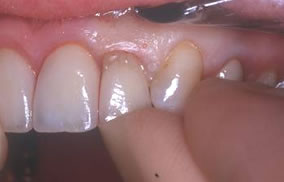
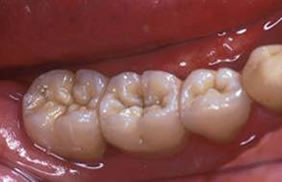
Zirconia strengths are comparable to metal.Zirconia is crack resistant, and undergoes a phenomenon called "transformation toughening". Zirconia's strength allows traditional PFM preparation design.
Lava's higher strength allows traditional cementation, as well as bonding Coping thicknesses can be as little as 3/10ths in the anterior resulting in:
Lava's Zirconia translucency is similar to natural dentin.
Zirconia is insoluble, which is important in regards to long-term strength.
Due to the strength of Zirconia', Lava's bridge connector sizes are esthetic and are comparable to the size of metal connectors Fits are similar or better than metal Being metal free, esthetics are naturally much better than PFM's
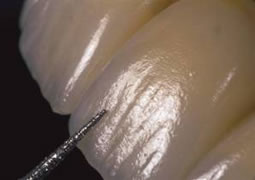

Processing Scheme
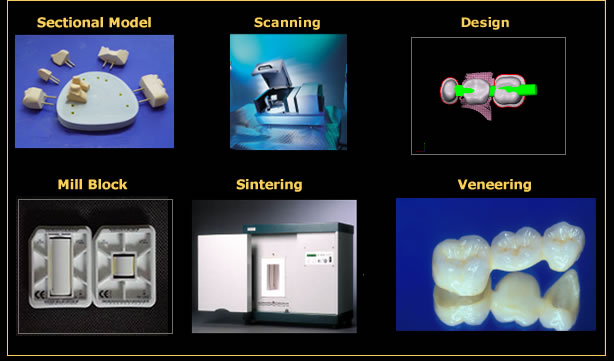
Previous All-Ceramic Crowns Disadvantages:


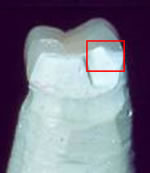
traditional problem with ceramics: Crack Propagation

